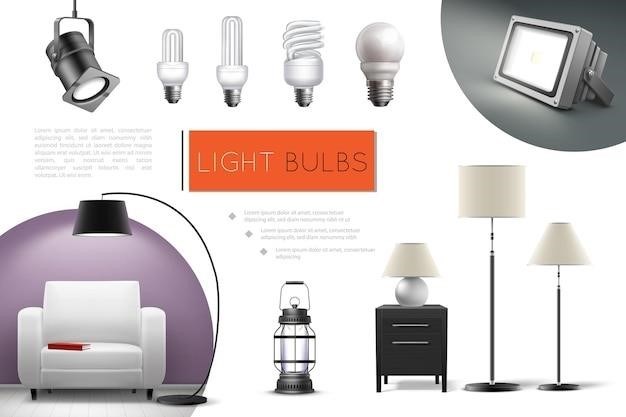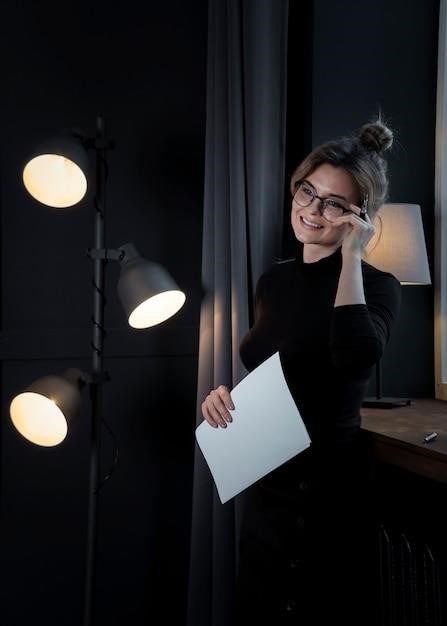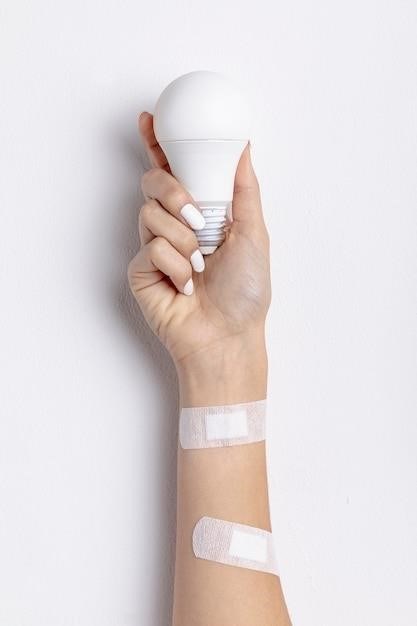
Lighting Design Fundamentals
Mastering lighting design involves understanding key elements⁚ light quality, color temperature, and brightness. These factors significantly influence the ambiance and functionality of any space. Careful consideration of these aspects is crucial for successful lighting projects. Choosing appropriate color temperatures creates specific moods and enhances the overall design aesthetic.
Understanding Light Quality, Color Temperature, and Brightness
Light quality encompasses several factors influencing a space’s perceived atmosphere. These include the spectral distribution of the light source, affecting color rendering and the appearance of objects. Color temperature, measured in Kelvin (K), determines the light’s “warmth” or “coolness,” ranging from warm yellow tones (2700K) to cool blueish white (6500K). Brightness, expressed in lumens or lux, quantifies the light’s intensity, directly impacting visibility and task performance. Selecting appropriate color temperatures sets the mood—warm for relaxation, cool for focus. Balancing these three elements achieves the desired aesthetic and functional lighting. Careful consideration ensures optimal visual comfort and enhances the overall design’s impact. Understanding these aspects is fundamental to effective lighting design.
Choosing the Right Color Temperature for Different Ambiances
Color temperature significantly impacts the mood and atmosphere of a space. Warmer color temperatures (2700-3000K), resembling incandescent bulbs, create cozy and inviting environments, ideal for living rooms, bedrooms, or dining areas where relaxation is key. Cooler temperatures (5000-6500K), similar to daylight, promote alertness and focus, making them suitable for kitchens, bathrooms, or home offices requiring concentration. Intermediate temperatures (3500-4100K) offer a balanced approach, suitable for hallways or general areas. The choice depends on the intended function and desired feeling. Consider the overall interior design and how the lighting interacts with colors and textures. Experimentation and careful selection are crucial to achieving the perfect ambiance with your chosen color temperature.

Types of Lighting and Their Applications
This section explores ambient, task, and accent lighting, crucial elements in any comprehensive lighting plan. Understanding their distinct roles and applications is vital for creating functional and aesthetically pleasing spaces.
Ambient, Task, and Accent Lighting⁚ A Comprehensive Overview
Ambient lighting provides overall illumination, setting the general mood and brightness of a room. Think of it as the foundational layer, establishing a comfortable and functional base level of light. Task lighting, conversely, is focused and directed, designed to illuminate specific work areas like countertops or desks. It ensures adequate illumination for detailed tasks, minimizing eye strain and improving efficiency. Accent lighting, the final layer, adds dramatic flair and visual interest. Used strategically to highlight architectural features, artwork, or decorative elements, it adds depth and personality to the space. The effective interplay of these three types of lighting is key to creating a well-designed and visually appealing environment. Careful consideration of their individual strengths allows for a lighting scheme that’s both functional and aesthetically pleasing, enhancing the overall atmosphere and purpose of the room.
General Lighting vs. Localized Lighting⁚ Key Differences and Uses
General lighting, also known as ambient lighting, provides even illumination across a large area, creating a uniform brightness suitable for overall visibility and setting the mood. It’s often achieved with ceiling fixtures or widespread light sources, ideal for larger spaces needing consistent illumination. Localized lighting, on the other hand, focuses light on specific areas or tasks. This targeted approach enhances functionality and visual appeal. Think task lighting for reading or preparing food, or accent lighting to highlight artwork. The key difference lies in their purpose; general lighting establishes a baseline, while localized lighting enhances specific areas. Choosing between these depends on the space’s function and desired atmosphere. A balanced approach often uses both for optimal functionality and aesthetic impact. Consider the specific needs of the room when designing your lighting scheme, combining general and localized lighting for a well-rounded result.
Designing for Specific Spaces
Tailoring lighting to specific rooms is crucial. Different spaces demand unique lighting solutions to optimize both functionality and atmosphere. Consider the room’s purpose and desired ambiance when planning your lighting design.
Kitchen Lighting Design⁚ A Detailed Guide
Effective kitchen lighting is essential for both functionality and aesthetics. A well-lit kitchen enhances food preparation, making tasks easier and safer. Consider a layered approach, combining ambient, task, and accent lighting to create a dynamic and inviting space. Ambient lighting provides overall illumination, while task lighting focuses on specific work areas like countertops and sinks. Accent lighting highlights architectural details or decorative elements, adding visual interest. Under-cabinet lighting is ideal for task illumination, preventing shadows and improving visibility. Pendant lights or chandeliers can serve as both ambient and accent lighting, adding a design element. Recessed lighting provides even illumination across the ceiling, eliminating dark spots. Remember to consider the color temperature of your lighting; warmer tones create a cozy atmosphere, while cooler tones offer a brighter, more energetic feel. Careful planning ensures a balanced and functional kitchen lighting scheme.
Bathroom Lighting⁚ Creating the Perfect Ambiance
Bathroom lighting design requires a nuanced approach, balancing functionality with ambiance. Adequate illumination is crucial for tasks like applying makeup or shaving, demanding bright, shadow-free lighting near mirrors. Vanity lighting, often integrated into the mirror frame or mounted on either side, directly addresses this need. However, solely functional lighting can feel sterile. Incorporate softer, ambient lighting to create a relaxing atmosphere. Recessed ceiling lights provide overall illumination, while dimmer switches allow for adjusting the intensity to suit the mood. Consider adding accent lighting to highlight architectural features or decorative elements, adding visual interest. The color temperature of your lighting is also important; warmer tones create a spa-like feel, while cooler tones offer a more invigorating ambiance. Experiment with different lighting layers to achieve the perfect balance of functionality and relaxation in your bathroom space. Remember to select fixtures with appropriate IP ratings for damp environments.
Living Room Lighting⁚ Setting the Mood
The living room, a central hub for relaxation and socializing, demands versatile lighting. Ambient lighting, often provided by a ceiling fixture or multiple strategically placed recessed lights, sets the overall tone. Consider the room’s size and ceiling height when choosing a fixture; a large room might benefit from a statement chandelier, while smaller spaces may prefer a more subtle approach. Task lighting, such as floor lamps or table lamps, is essential for reading or other activities requiring focused illumination. These can be placed near seating areas or reading nooks, providing concentrated light without disrupting the ambient lighting. Accent lighting adds a touch of drama and personality. Highlight artwork, architectural details, or decorative objects with strategically placed spotlights or LED strips to create visual interest and depth. A dimmer switch allows you to effortlessly adjust the intensity and mood, transforming the space from bright and energetic to cozy and intimate. Remember to consider the color temperature of your lighting; warm tones create a welcoming atmosphere, whereas cooler tones offer a more modern feel.
Lighting Standards and Certifications
Understanding lighting certifications (UL, CSA, ETL, CE) and key standards (like IEC 60598) ensures safety and performance. These certifications verify adherence to safety and quality guidelines, providing assurance for consumers and professionals.
Understanding Lighting Certifications (UL, CSA, ETL, CE)
Numerous organizations establish standards addressing lighting design, safety, performance, mounting, and testing, including illumination levels; Understanding these certifications—UL (Underwriters Laboratories), CSA (Canadian Standards Association), ETL (Intertek), and CE (Conformité Européenne)—is crucial. UL, a global safety science company, tests and certifies products to ensure they meet safety requirements. CSA Group provides similar testing and certification services, primarily in North America. ETL, another prominent testing and certification body, offers global services. The CE mark indicates conformity with health, safety, and environmental protection standards within the European Economic Area.
These certifications are vital for ensuring the safety and reliability of lighting products. They provide independent verification that products meet specific standards, reducing risks and promoting consumer confidence. Always check for relevant certifications when selecting lighting for any project, guaranteeing quality and safety.
Key Standards and Guidelines for Lighting Design (e.g., IEC 60598)
Several key standards and guidelines govern lighting design, ensuring safety, efficiency, and performance. IEC 60598, a prominent international standard, specifies general requirements for luminaires (lighting fixtures), covering aspects from safety to performance. It details specifications for various luminaire types, operating voltages, and environmental conditions. Adherence to IEC 60598 is vital for ensuring product safety and reliability. Other crucial standards address specific aspects of lighting design, such as energy efficiency, color rendering, and glare control. These standards often vary by region and may be incorporated into national building codes and regulations.
Understanding and applying these standards are essential for any lighting designer. They provide a framework for creating safe, efficient, and effective lighting systems that meet both functional and aesthetic goals. Professional lighting designers frequently consult these standards and guidelines to ensure their designs comply with all relevant regulations and best practices.

Advanced Lighting Design Techniques
Explore sophisticated lighting strategies, integrating illumination seamlessly with architectural and interior design elements. Mastering these techniques elevates projects to new levels of visual impact and functionality.
The Role of Lighting in Architectural Design
Lighting is integral to architectural design, shaping not only the visual appeal but also the functionality and atmosphere of a building. Skilled lighting design enhances architectural features, highlighting textures, and creating dramatic effects. The interplay of light and shadow can dramatically alter the perception of space, making ceilings appear higher or rooms feel more expansive. Careful placement of light sources can guide movement, emphasize focal points, and create a sense of flow throughout the structure. Different lighting schemes can transform the ambiance of a space, from a warm and inviting atmosphere to a cool and modern feel. Moreover, architectural lighting design must balance aesthetic considerations with energy efficiency and sustainability goals. The selection of fixtures, their energy consumption, and the control systems employed all contribute to the overall environmental impact of the building.
Integrating Lighting with Interior Design
Successful interior design hinges on the thoughtful integration of lighting, seamlessly blending form and function. Lighting choices directly influence the mood and atmosphere of a space, impacting how people perceive and interact with their environment. The style of the lighting fixtures should complement the overall interior design aesthetic, whether it’s modern minimalism, rustic charm, or classic elegance. Beyond aesthetics, lighting plays a crucial role in highlighting key features, such as artwork or architectural details. Layered lighting, incorporating ambient, task, and accent lighting, provides versatility and control, allowing users to adjust the illumination level and mood to suit different activities and times of day. Careful consideration of color temperature and light intensity ensures visual comfort and prevents harsh shadows or glare. Ultimately, the seamless integration of lighting with interior design creates a cohesive and harmonious living space that is both beautiful and functional.
Resources and Further Learning
Numerous handbooks and guides offer comprehensive information on lighting design principles and best practices. These resources provide valuable insights for both beginners and experienced professionals.
Recommended Handbooks and Guides on Lighting Design
Several excellent resources provide in-depth guidance on lighting design. The “Handbook of Lighting Design” offers a comprehensive overview of architectural lighting principles and practices, serving as a valuable teaching tool for students and professionals alike. For those focused on stage lighting, Susan S. Szenasy’s “Light⁚ The Complete Handbook of Lighting Design” is highly recommended, providing a detailed exploration of the subject. Complementing these are numerous online guides and articles offering practical advice on various aspects of lighting design, from choosing the right color temperature to understanding lighting certifications (UL, CSA, ETL, CE). These resources collectively provide a wealth of knowledge, covering topics such as residential lighting principles, energy efficiency, and the integration of lighting with interior design concepts.